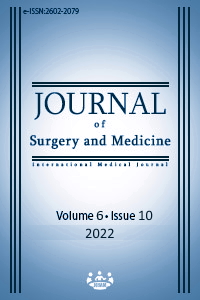Metastatic multiple gastric neuroendocrine tumors with a long history of proton pump inhibitor use: A case report
Gastric neuroendocrine tumor and proton pump inhibitor usage
Keywords:
Stomach, Neuroendocrine tumor, Proton pump inhibitor usageAbstract
It is widely accepted that gastric neuroendocrine tumors (NETs) develop due to enterochromaffin-like (ECL) cell proliferation following exposure to hypergastrinemia, which causes hyperplastic-dysplastic-neoplastic changes. Here we describe the case of a 46-year-old female patient diagnosed with metastatic NETs by liver biopsy and evaluated at an external center. At our hospital, nodular structures extending from the cardia to the antrum were observed by gastroscopy, considered the primary tumor focus. Histopathological examination revealed a trabecular-insular pattern, with microNETs consisting of monotone cells with round-oval nuclei and surrounding neuroendocrine cell hyperplasia foci and fundic gland polyps. The patient had a history of regular proton pump inhibitor (PPI) use for 10 years and a serum gastrin of 9240 pg/mL. A 3-cm metastatic lesion in the left lobe of the liver was observed in whole-body imaging with octreotide. By gastrectomy, we observed a large number of nodular lesions in the corpus-antrum and a 3-cm diameter lesion in the hepatectomy material. Histopathological examination revealed NETs in multiple foci with submucosal invasion in the stomach. The Ki-67 proliferative index was 3%. Metastatic tumors of similar morphology were found in the liver and three of the greater curvature lymph nodes. We made a diagnosis of multiple gastric NETs (Grade 2). In Type I gastric NETs, the neuroendocrine cell proliferation spectrum up to NET is observed as a result of hypergastrinemia due to atrophic gastritis. Also, in experimental studies, prolonged hypergastrinemia has been reported to cause ECL cell neoplasms in animals treated with PPIs. Although our case could be accepted as Type 1 NET, the possibility of developing NET secondary to long-term PPI use should also be considered.
Downloads
References
Li T, Qiu F, Qian ZR, Wan J, Qi X, Wu B. Classification, clinicopathologic features and treatment of gastric neuroendocrine tumors. World J Gastroenterol. 2014;20(1):118-25. doi: 10.3748/wjg.v20.i1.118. DOI: https://doi.org/10.3748/wjg.v20.i1.118
Yang Z, Wang W, Lu J, Pan G, Pan Z, Chen Q, et al. Gastric neuroendocrine tumors (G-Nets): Incidence, prognosis and recent trend toward improved survival. Cell Physiol Biochem. 2018;45(1):389-96. doi: 10.1159/000486915. DOI: https://doi.org/10.1159/000486915
Modlin IM, Kidd M, Lye KD. Biology and management of gastric carcinoid tumours: A review. Eur J Surg. 2002;168(12):669-83. doi: 10.1080/11024150201680022. DOI: https://doi.org/10.1080/11024150201680022
Vanoli A, La Rosa S, Luinetti O, Klersy C, Manca R, Alvisi C, et al. Histologic changes in Type A chronic atrophic gastritis indicating increased risk of neuroendocrine tumor development: the predictive role of dysplastic and severely hyperplastic enterochromaffin-like cell lesions. Hum Pathol. 2013;44(9):1827-37. doi: 10.1016/j.humpath.2013.02.005. DOI: https://doi.org/10.1016/j.humpath.2013.02.005
Cockburn AN, Morgan CJ, Genta RM. Neuroendocrine proliferations of the stomach: A pragmatic approach for the perplexed pathologist. Adv Anat. 2013;20(3):148-57. doi: 10.1097/PAP.0b013e31828d185d. DOI: https://doi.org/10.1097/PAP.0b013e31828d185d
La Rosa S, Rindi G, Solcia E, Tang LH. Gastric neuroendocrine neoplasms. In: WHO classification of tumours eds. Digestive System Tumours. Lyon: World Health Organization; 2019.pp.104-8.
Lundell L, Vieth M, Gibson F, Nagy P, Kahrilas PJ. Systematic review: The effects of long-term proton pump inhibitör use on serum gastrin levels and gastric histology. Aliment Pharmacol Ther. 2015;42(6):649-63 doi: 10.1111/apt.13324. DOI: https://doi.org/10.1111/apt.13324
Burkitt MD, Varro A, Pritchard DM. Importance of gastrin in the pathogenesis and treatment of gastric tumors. World J Gastroenterol. 2009;15(1):1-16. doi: 10.3748/wjg.15.1. DOI: https://doi.org/10.3748/wjg.15.1
Tatsuguchi A, Hoshino S, Kawami N, Gudis K, Nomura T, Shimizu A, et al. Influence of hypergastrinemia secondary to long-term proton pump inhibitor treatment on ECL cell tumorigenesis in human gastric mucosa. Pathol Res Pract. 2020;216(10):153113. doi: 10.1016/j.prp.2020.153113. DOI: https://doi.org/10.1016/j.prp.2020.153113
Jianu CS, Fossmark R, Viset T, Qvigstad G, Sordal O, Marvik R, et al. Gastric carcinoids after long-term use of a proton pump inhibitor. Aliment Pharmacol Ther. 2012;36(7):644-9. doi: 10.1111/apt.12012. DOI: https://doi.org/10.1111/apt.12012
Cavalcoli F, Zilli A, Conte D, Ciafardini C, Massironi S. Gastric neuroendocrine neoplasms and proton pump inhibitors: fact or coincidence? Scand J Gastroenterol. 2015;50(11):1397-403. doi: 10.3109/00365521.2015.1054426. DOI: https://doi.org/10.3109/00365521.2015.1054426
Jianu CS, Lange OJ, Viset T, Qvigstad G, Martinsen TC, Fougner R, et al. Gastric neuroendocrine carcinoma after long-term use of proton pump inhibitor. Scand J Gastroenterol. 2012;47(1):64-7. doi: 10.3109/00365521.2011.627444. DOI: https://doi.org/10.3109/00365521.2011.627444
Trinh VQ-H, Shi C, Ma C. Gastric neuroendocrine tumours from long-term proton pump inhibitor users are indolent tumours with good prognosis. Histopathol. 2020;77(6):865-76. doi: 10.1111/his.14220. DOI: https://doi.org/10.1111/his.14220
Kinoshita Y, Ishimura N, Ishihara S. Advantages and disadvantages of long-term proton pump inhibitor use. J Neurogastroenterol Motil. 2018;24(2):182-96. doi: 10.5056/jnm18001. DOI: https://doi.org/10.5056/jnm18001
Fitzgibbons PL, Jamidar PA. The effect of long-term acid suppression on gastric mucosal histology. Am J Clin Pathol. 1998;110:569-71. DOI: https://doi.org/10.1093/ajcp/110.5.569
Brusselaers N, Wahlin K, Engstrand L, Lagergren J. Maintenance therapy with proton pump inhibitors and risk of gastric cancer: a nationwide population-based cohort study in Sweden. BMJ Open. 2017;7(10):e017739. doi: 10.1136/bmjopen-2017-017739. DOI: https://doi.org/10.1136/bmjopen-2017-017739
Savarino V, Dulbecco P, Savarino E. Are proton pump inhibitors really so dangerous? Dig Liv Dis. 2016;48(8):851-9. doi: 10.1016/j.dld.2016.05.018. DOI: https://doi.org/10.1016/j.dld.2016.05.018
Soto-Solis R, Romano-Munive AF, Anda KS, Barreto-Zuniga R. Factors related to gastric neuroendorine tumors. Revista de Gastroenterología de México. 2019;84(1):52-6. doi: 10.1016/j.rgmxen.2018.06.007. DOI: https://doi.org/10.1016/j.rgmxen.2018.06.007
Burkitt MD, Pritchard DM. Review article: Pathogenesis and management of gastric carcinoid tumours. Aliment Pharmoacol Ther. 2006;24:1305-20. doi: 10.1111/j.1365-2036.2006.03130.x. DOI: https://doi.org/10.1111/j.1365-2036.2006.03130.x
Modlin IM, Moss SF, Oberg K, Padbury R, Hicks RJ, Gustafsson BI, et al. Gastrointestinal neuroendocrine (carcinoid) tumours: Current diagnosis and management. Med J Aust. 2010;193(1):46-52. doi: 10.5694/j.1326-5377.2010.tb03742.x. DOI: https://doi.org/10.5694/j.1326-5377.2010.tb03742.x
Furumoto K, Kojima H, Okuno M, Fuji H, Mizuno R, Mori TM, et al. Gastric carcinoid with hypergastrinemia: Report of three cases. Case Reports Med. 2010;2010:348761. doi: 10.1155/2010/348761. DOI: https://doi.org/10.1155/2010/348761
Postlewait LM, Baptiste GG, Ethun CG, Le N, Cardona K, Russel MC, et al. A 15-year experience with gastric neuroendocrine tumors: Does Type make a difference? J Surg Oncol. 2016;114(5):576-80. doi: 10.1002/jso.24369. DOI: https://doi.org/10.1002/jso.24369
Downloads
- 550 1245
Published
Issue
Section
How to Cite
License
Copyright (c) 2022 Selma Şengiz Erhan , Aytül Buğra , Sevinç Hallaç Keser , Ali Alemdar
This work is licensed under a Creative Commons Attribution-NonCommercial-NoDerivatives 4.0 International License.
















